
What is St David’s Day?
On the 1st of March, every year, St David’s Day is celebrated in Wales and beyond. The day is also known as “the feast day of St David.” The celebration is most commonly associated with daffodils, leeks and the coming of spring and warmer weather. St David, in the sixth century, was a Celtic monk and was believed to be a miracle worker; he is celebrated every year for his altruistic acts and healing abilities. The 1st of March was the day he died, so it is a memorial day for the saint and celebrates all the work he did, as well as celebrating Wales itself and its magnificent rich culture. He died in the year 589 and is still celebrated fondly today.
Throughout the day, many celebrations happen across the country. That can include parades (such as the one in Cardiff) which showcases all of Wales’ wonderful history and culture and bring communities together to enjoy the festivities.
Who is St David?
St David’s last words were recorded as “Be joyful, keep the faith and do the little things” which is a motto you’ll often hear repeated throughout Wales on this special day, with a special emphasis on ‘do the little things’. He is buried at St David’s Cathedral in St David’s, Pembrokeshire, where many people take a pilgrimage throughout the year as well as this special day.
He was known in his life to be a very disciplined individual. As a monk, he spent many hours a day ploughing fields and doing hard labour. As well as this, he also practiced a very plain diet, with no meat or anything of luxury and lived very frugally. This was believed to help with reaching enlightenment. Some people speculated all he ate was leeks (which is where the symbolism comes from today!) while others believed he lived on a simple diet of bread and greens. He did so without complaint and spent a lot of his time teaching and helping the local communities with healing and preaching.
Many religious buildings such as churches, cathedrals and monasteries exist because of St David himself. He eventually became an archbishop of Mynyw (which is now of course known as St David’s).
How is it celebrated?
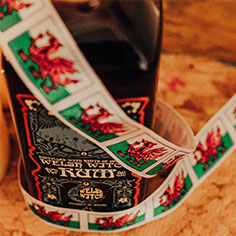 Of course, everybody’s way of celebrating St David’s Day is individual, but there is no doubt that Wales on the 1st of March is extra patriotic and full of enthusiasm. Some schools may encourage traditional Welsh attire, such as Welsh dresses and black hats or Welsh football and rugby shirts. For those not dressing up, adorning your outfit with the Welsh daffodil or a leek is very common and you’re likely to see lots of them around March time.
Of course, everybody’s way of celebrating St David’s Day is individual, but there is no doubt that Wales on the 1st of March is extra patriotic and full of enthusiasm. Some schools may encourage traditional Welsh attire, such as Welsh dresses and black hats or Welsh football and rugby shirts. For those not dressing up, adorning your outfit with the Welsh daffodil or a leek is very common and you’re likely to see lots of them around March time.
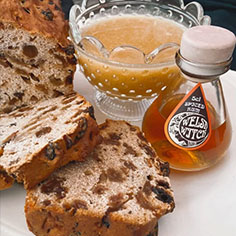 Traditional Welsh food, such as Welsh cakes and the Bara Brith are consumed around this time in particular, to honour the Welsh culture and heritage. Foods such as ‘cawl’ (a meat and root vegetable stew or soup) are often eaten together with loved ones around this time too. Food is often a big part of celebrations, whatever the religion or culture, so this is no exception! If you’d like to try out a new recipe, our traditional Welsh Bara Brith and Welsh Witch Spiced Rum Butter Sauce is a great choice!
Traditional Welsh food, such as Welsh cakes and the Bara Brith are consumed around this time in particular, to honour the Welsh culture and heritage. Foods such as ‘cawl’ (a meat and root vegetable stew or soup) are often eaten together with loved ones around this time too. Food is often a big part of celebrations, whatever the religion or culture, so this is no exception! If you’d like to try out a new recipe, our traditional Welsh Bara Brith and Welsh Witch Spiced Rum Butter Sauce is a great choice!
Ways to enjoy the Welsh day
Even if you’re not Welsh, there are still wonderful ways you can celebrate the 1st of March. Here are some Welsh Witch ways to enjoy some magic of Wales:
Go on a daffodil walk
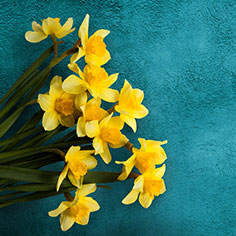 Of course Wales is associated with daffodils (supposedly because the daffodil flower is very similar to the leek flower – which is the symbol of St David), so finding a lovely trail to walk along in early March is a way to honour your Welsh roots or just appreciate the beauty of spring itself! Look out for the blooming daffodils that pop up everywhere this time of year and say a little blessing for the warmth of spring arriving!
Of course Wales is associated with daffodils (supposedly because the daffodil flower is very similar to the leek flower – which is the symbol of St David), so finding a lovely trail to walk along in early March is a way to honour your Welsh roots or just appreciate the beauty of spring itself! Look out for the blooming daffodils that pop up everywhere this time of year and say a little blessing for the warmth of spring arriving!
Visit Wales!
If you aren’t Welsh but you’re able to do so, visiting Wales during a time of celebration is a great way to dive deep into the culture and heritage. The 1st of March is an excellent time to visit if you’re looking to enjoy the parades or traditional attire of Welsh culture. Taste some authentic Welsh foods and soak up the festive celebrations! Here’s a little fun fact for you: the oldest monastery in Britain can be found in Wrexham, where Welsh Witch Craft Spirits was founded, called Bangor-on-Dee.
Enjoy some local Welsh magic
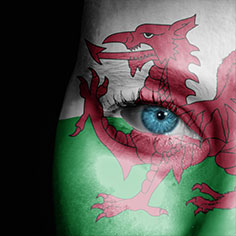 Our Welsh Witch Craft Spirits are brewed and created right here in North Wales. Made from local ingredients and healing Welsh water, our premium Welsh spirits are perfect for celebrating the Welsh festive day. You can shop our award-winning spirits here from the Wild Moon Distillery, or in store from several stockists in Wales.
Our Welsh Witch Craft Spirits are brewed and created right here in North Wales. Made from local ingredients and healing Welsh water, our premium Welsh spirits are perfect for celebrating the Welsh festive day. You can shop our award-winning spirits here from the Wild Moon Distillery, or in store from several stockists in Wales.
However you choose to celebrate the day, we hope you have a magical one! Welsh folk are often very proud of their roots, so if you know someone who is Welsh, they’re probably more than likely to indulge you about some facts about their heritage if you ask nicely!
We’re wishing you a merry and magical day, and all of us at Welsh Witch HQ hope you spend it with a full heart.
Dydd Gŵyl Dewi Hapus,
Welsh Witch HQ x
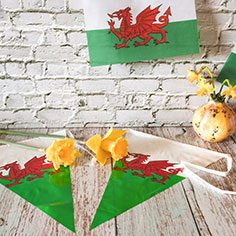

 Welsh Love Spoons, intricately carved wooden spoons, are another traditional gift exchanged on this day. Each symbol on the spoon carries a specific meaning, representing wishes for the couple’s future together.
Welsh Love Spoons, intricately carved wooden spoons, are another traditional gift exchanged on this day. Each symbol on the spoon carries a specific meaning, representing wishes for the couple’s future together.